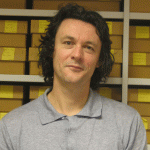Scott Trowell – Question 2
April 2014
2To what extent do previous representations (such as editions) of the archives with which you work – or the lack thereof – affect new representations of them?
Clare Scott
Faculty of Arts and Humanities Librarian – University of Sheffield
Ian Trowell
Collections Manager for National Fairgrounds Archive, Western Bank Library – University of Sheffield
¶ 1 Leave a comment on paragraph 1 0 The National Fairground Archive (NFA) is a unique collection of material covering all aspects of the culture and history of traveling fairs and entertainment from the 1800s to the present day. Collections include printed works, manuscript material, and audio-visual material, but chiefly photographic material. Many donations have come from fairground enthusiasts and form collections of photographs with associated notebooks. There is also a large collection of ephemeral printed advertising material such as posters and handbills.
¶ 2 Leave a comment on paragraph 2 0 As stated in Question 1, we do not work with facsimile printed representations of collections. We do work with a large variety of people who re-present our collections in creative ways, and so we can give some insight into this process.
¶ 3 Leave a comment on paragraph 3 0 Our collections at the NFA form what is known as a living archive. This is a term that does not have a fixed definition; however, we feel it is well suited to the material and subject areas with which we work. Whilst in simple terms a living archive may mean that new material is constantly being generated and deposited within the archive, we can also consider the subject matter itself as a living history. This implies that new material is not just being produced in real time, but that the form and focus of that material is changing over time. Fairground technology and social and cultural ties manifested and exploited within the fairground are constantly evolving and changing. Any shift in social technologies or cultural forms in the wider world will be reflected both in the fairground and the ways in which documenters of the fairground and potential archive donors engage with their tasks, shaping what they may have actually seen, what they chose to see, and how they interpret and document it. Moreover, as the collections accrue through time, with new deposits representing both the “distant past” and the “immediate past,” there is a further living aspect to the archive in that foundation deposits can garner new meanings and uses as the present is understood through the past and the past is understood through the present.
¶ 4 Leave a comment on paragraph 4 0 We seek to represent this by showcasing a series of “user journey” case studies. For this we pick interesting projects that have both purposeful approaches to the material and distinctive outputs. We have included a variety of case studies including model makers consulting notebooks to access information about the color schemes of vehicles that they wish to reproduce in their model-making as well as use of materials in the Archive by contemporary poster designers. The aim is to inspire ideas and confidence in others to approach the material in similar (or similarly different) ways. In an entry in her blog, Archinodes, Melanie Hogan gives one of the few definitions of a “living archive” that fits this activity, suggesting that it “encourages researchers to make connections between materials and to map out their own archival journeys in hopes of revealing new ways of looking at the future by examining the past.”1 This is possibly the closest we come to publishing representations of the archive.
- ¶ 5 Leave a comment on paragraph 5 0
- “LIFT 2010,” London International Festival of Theatre, http://www.liftfestival.com/content_category/1676/archive/2010. [↩]



0 Comments on the whole post
Leave a comment on the whole post
0 Comments on paragraph 1
Leave a comment on paragraph 1
0 Comments on paragraph 2
Leave a comment on paragraph 2
0 Comments on paragraph 3
Leave a comment on paragraph 3
0 Comments on paragraph 4
Leave a comment on paragraph 4
0 Comments on paragraph 5
Leave a comment on paragraph 5